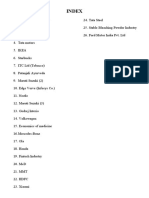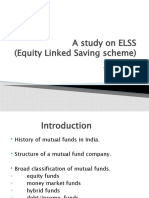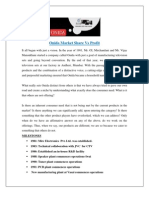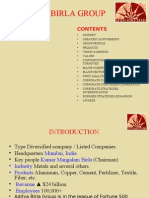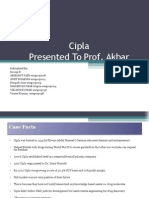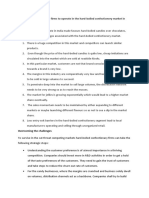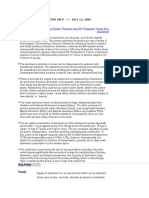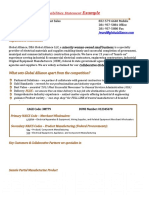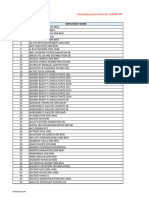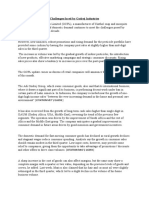Aluminum Porter
Aluminum Porter
Uploaded by
Amir ShameemCopyright:
Available Formats
Aluminum Porter
Aluminum Porter
Uploaded by
Amir ShameemOriginal Description:
Copyright
Available Formats
Share this document
Did you find this document useful?
Is this content inappropriate?
Copyright:
Available Formats
Aluminum Porter
Aluminum Porter
Uploaded by
Amir ShameemCopyright:
Available Formats
Aluminium industry in India through Porters five forces:
1. Market Rivalry: Being a commodity, there is less differentiation and hence the competition is primarily on quality and price. Cost efficiency is the key. Low cost manufacturer are benefitted. Major Players- Hindalco, Nalco, Vedanta. The fully vertically integrated companies dominate the industry in size. Value addition has helped in protecting companies from competitive pressure from downstream industries. Significant economies of scale helps in lowering the cost. 2. Entry Barrier: a. Economies of scale: As far as the sector forces go, scale of operation does matter. Benefits of economies of scale are derived in the form of lower costs and better bargaining power while sourcing raw materials. It may be noted that the minimum economic size of a fully integrated greenfield smelter is around 250,000 tonnes. The aluminium companies, which are integrated, have their own mines for key raw materials such as bauxite and coal and this protects them from the potential threat for new entrants to a significant extent. They also have their own power plants as it is a major cost driver. b. Capital Intensive: Aluminium industry is a highly capital intensive business. An economically viable project would cost around 13-14000 Cr investment. c. Higher gestation period: The gestation period for an economically viable green field plant is over 4 years while for a brownfield project, (modernization / capacity addition) the gestation period is relatively lower between 1.5 years to 2 years. d. Government Policies: The government has a favorable policy towards aluminium manufacturers. In fact to protect the domestic industry, recently, the government has imposed duty on value added products like foils and rolled products from the Chinese markets. However, similar to other sectors, there are certain discrepancies involved in allocation of mines and land acquisitions. Furthermore, regulatory clearances and other issues are some of the major problems for the new entrants.
3. Bargaining power of suppliers:
Low for fully integrated plant.
4. Bargaining power of Customer:
Being a commodity, customers enjoy relatively high bargaining power as prices are determined on demand and supply. 5. Threat of substitute: Major substitute are steel and copper. There is threat for aluminium from substitutes such as steel due to lower cost, and copper due to higher conductivity. However due to high strength and weight ratio, durability high corrosive resistance, makes the threats from substitutes low. Also the per capita consumption of aluminium in india is relatively very low as compared to USA and China. And the industry is growing at the rate of 7-9% annually, and there is potential for more growth in the sector.
You might also like
- Flight TicketDocument3 pagesFlight TicketAkshay KanyanNo ratings yet
- Porters Five Force AnalysisDocument4 pagesPorters Five Force AnalysisBinoo ChandranNo ratings yet
- Porter Five Forces Analysis Steel IndustryDocument8 pagesPorter Five Forces Analysis Steel Industrydivakar62100% (3)
- Temporal Price VariationDocument10 pagesTemporal Price VariationFrancis Joseph Malabayabas LopenaNo ratings yet
- Project Proposal-Warehouse Rack - NewDocument53 pagesProject Proposal-Warehouse Rack - NewRashan Jida ReshanNo ratings yet
- Pdfanddoc 29120Document71 pagesPdfanddoc 29120Abhishek Agrawal0% (1)
- Report On Steel IndustryDocument15 pagesReport On Steel Industrysiddhesh4788No ratings yet
- SOM Project - Group 3Document12 pagesSOM Project - Group 3kumarNo ratings yet
- Group 1 Sec B Cottle IndiaDocument9 pagesGroup 1 Sec B Cottle Indiasujeet palNo ratings yet
- Pink - Abstract GD Topic - Group Discussion Ideas PDFDocument5 pagesPink - Abstract GD Topic - Group Discussion Ideas PDFAshutosh SharmaNo ratings yet
- Marico - Over The WallDocument12 pagesMarico - Over The WallsahilsureshNo ratings yet
- Strategic Management-Final Project On Kingfisher AirlinesDocument16 pagesStrategic Management-Final Project On Kingfisher Airlinesprashant agraNo ratings yet
- Fiitjee JD National Head Academic Delivery Strategic Result AssuranceDocument2 pagesFiitjee JD National Head Academic Delivery Strategic Result AssuranceVaishnaviRaviNo ratings yet
- Strategy Management Project Indigo AirlinesDocument36 pagesStrategy Management Project Indigo AirlinesPRITAM MONDALNo ratings yet
- b2b AssignDocument2 pagesb2b AssignShubham JakhmolaNo ratings yet
- SAILDocument18 pagesSAILSumeet DubeyNo ratings yet
- Byju The Learning App Case Study NotesDocument3 pagesByju The Learning App Case Study NotesRajarshi Choudhury100% (1)
- Imc Project On CadburyDocument33 pagesImc Project On CadburyTehniat HamzaNo ratings yet
- HT MediaDocument26 pagesHT MediathreeinvestigatorsNo ratings yet
- Hindalco Novelis MergerDocument6 pagesHindalco Novelis Mergermonish147852100% (1)
- CSR in India: From Voluntary To Mandatory?Document12 pagesCSR in India: From Voluntary To Mandatory?adsfdgfhgjhkNo ratings yet
- Infosys Product PortfolioDocument6 pagesInfosys Product PortfolioPrachi AsawaNo ratings yet
- Copeland Corporation Synopsis Group 6Document2 pagesCopeland Corporation Synopsis Group 6mannu bansalNo ratings yet
- Group-3 - Tata Bluescope Case - BWDocument21 pagesGroup-3 - Tata Bluescope Case - BWAnkit Bansal100% (2)
- 4Ps of AmulDocument2 pages4Ps of AmulhardikNo ratings yet
- Eco AssignmentDocument27 pagesEco AssignmentBiswaranjan BeheraNo ratings yet
- Case Study On DDD AsifDocument3 pagesCase Study On DDD AsifPrince M.No ratings yet
- Brand Pipe Company: Group 3Document10 pagesBrand Pipe Company: Group 3Rama KantNo ratings yet
- SM AssignesDocument8 pagesSM AssignesYugandhar MakarlaNo ratings yet
- Group2 HRM Project ReportDocument16 pagesGroup2 HRM Project ReportzebNo ratings yet
- Group 5 - OYODocument24 pagesGroup 5 - OYORUCHIKA SAXENA MBA W 2021-24No ratings yet
- Competition Analysis On Iron and Steel IndustryDocument18 pagesCompetition Analysis On Iron and Steel Industryatre100% (1)
- Consumer Durables Industry in IndiaDocument11 pagesConsumer Durables Industry in IndiaSiba PrasadNo ratings yet
- Deloitte and KPMG: War For TalentDocument4 pagesDeloitte and KPMG: War For TalentVinod Mathews100% (4)
- Distribution Channel of LGDocument3 pagesDistribution Channel of LGBadal BhattacharyaNo ratings yet
- Valuation of GCPLDocument51 pagesValuation of GCPLMaruthi RamNo ratings yet
- A Case Study and Presentation of TATA NANODocument11 pagesA Case Study and Presentation of TATA NANOK Y RajuNo ratings yet
- Parle Products Presentation On FMCGDocument14 pagesParle Products Presentation On FMCGManas KumarNo ratings yet
- Micro AnalysisDocument289 pagesMicro AnalysisAPOORV ASTHANANo ratings yet
- Project CSMDocument39 pagesProject CSMrakeshNo ratings yet
- 2018PGP039 Jyothy LaboratoriesDocument5 pages2018PGP039 Jyothy LaboratoriesrupaliNo ratings yet
- Data VastDocument11 pagesData VastHimesh AnandNo ratings yet
- A PPT On ELSSDocument21 pagesA PPT On ELSSVinay BhargavaNo ratings yet
- Onida Case Study at Mark U Transit SIMSR MumbaiDocument8 pagesOnida Case Study at Mark U Transit SIMSR MumbaiAshish DuttNo ratings yet
- Aditya Birla Group - BPSM For MbaDocument27 pagesAditya Birla Group - BPSM For Mbasagar77_l86% (7)
- Amazon IndiaDocument24 pagesAmazon IndiaNikhil RaiNo ratings yet
- Micromax, Once A Rising Star, Now Struggles: in 2018, Micromax Along With Lava, Intex and Others To Lay Off in - ShopDocument21 pagesMicromax, Once A Rising Star, Now Struggles: in 2018, Micromax Along With Lava, Intex and Others To Lay Off in - ShopDesktop PCNo ratings yet
- V-Guard - Case PDFDocument20 pagesV-Guard - Case PDFFood On ThoughtNo ratings yet
- Group 8 CiplaDocument13 pagesGroup 8 CiplaPriya Singh0% (1)
- Discuss The Challenges For Firms To Operate in The Hard-Boiled Confectionery Market in India?Document4 pagesDiscuss The Challenges For Firms To Operate in The Hard-Boiled Confectionery Market in India?harryNo ratings yet
- Aluminium Industry in IndiaDocument9 pagesAluminium Industry in IndiaPartha Sarathi MohapatraNo ratings yet
- Strategic Management, Jindal SteelDocument12 pagesStrategic Management, Jindal Steellino67% (3)
- Brand Positioning & Differentiation Strategy of Volkswagen in IndiaDocument10 pagesBrand Positioning & Differentiation Strategy of Volkswagen in Indiambogadhi0% (1)
- Marketing Project On LorealDocument47 pagesMarketing Project On LorealHelpdeskNo ratings yet
- Aluminium FoilDocument45 pagesAluminium FoilBeing Aditya Joshi0% (1)
- Situation AnalysisDocument10 pagesSituation AnalysisRezwana Newaz SuroviNo ratings yet
- Arvind SinhaDocument12 pagesArvind Sinhapramit04No ratings yet
- Indian Aluminium IndustryDocument6 pagesIndian Aluminium IndustryAmrisha VermaNo ratings yet
- Steel and Iron Industry AnalysisDocument7 pagesSteel and Iron Industry AnalysisRhutika KuwarNo ratings yet
- Aluminiu M: Research It! Sector Info July 13, 2009Document4 pagesAluminiu M: Research It! Sector Info July 13, 2009vinodmaliwalNo ratings yet
- Case AnalysisToyotaDocument2 pagesCase AnalysisToyotaAmir Shameem100% (1)
- Case Analysis When New Products and Customer Loyality CollideDocument2 pagesCase Analysis When New Products and Customer Loyality CollideAmir ShameemNo ratings yet
- Samsung Pestel AnalysisDocument1 pageSamsung Pestel AnalysisAmir ShameemNo ratings yet
- Visa ProceduresDocument225 pagesVisa ProceduresAmir ShameemNo ratings yet
- Visa ProceduresDocument225 pagesVisa ProceduresAmir ShameemNo ratings yet
- What Is An ArgumentDocument2 pagesWhat Is An ArgumentAmir ShameemNo ratings yet
- FMS PAPER: (10-01-2010) : For Free Online Tests, Login ToDocument10 pagesFMS PAPER: (10-01-2010) : For Free Online Tests, Login ToAmir ShameemNo ratings yet
- Project Report HR PoliciesDocument94 pagesProject Report HR Policiessantoshkohli100% (1)
- Legaspi, Christian S. Bse Iii-Filipino Activity 1Document13 pagesLegaspi, Christian S. Bse Iii-Filipino Activity 1Lycea Femaica Valdez100% (2)
- Chapter 2 Incomes Which Do Not Form Part of Total IncomeDocument46 pagesChapter 2 Incomes Which Do Not Form Part of Total Incomerachitaggarwal.rnmNo ratings yet
- Yara Brasil PDFDocument91 pagesYara Brasil PDFChristopher GarciaNo ratings yet
- Mapecon Phils., Inc.-Gensan Branch Collection: MONTH OF December 2010Document32 pagesMapecon Phils., Inc.-Gensan Branch Collection: MONTH OF December 2010April Rose OctavioNo ratings yet
- Final Proposal Genevieve FischerDocument10 pagesFinal Proposal Genevieve Fischerapi-515910508No ratings yet
- Location Planning and Analysis: Topic ViiiDocument14 pagesLocation Planning and Analysis: Topic ViiiRia Bryle100% (1)
- Focus On Ag: Written by Kent Thiesse Farm Management Analyst and Senior Vice President, Minnstar BankDocument3 pagesFocus On Ag: Written by Kent Thiesse Farm Management Analyst and Senior Vice President, Minnstar BankFluenceMediaNo ratings yet
- Job Batch Costing-PQDocument9 pagesJob Batch Costing-PQRohaib MumtazNo ratings yet
- 198 - Commercial FishingDocument8 pages198 - Commercial Fishingkimsitchon11No ratings yet
- Downloads-Revised Vendor List July 08Document21 pagesDownloads-Revised Vendor List July 08Sachin Kumar RuhelaNo ratings yet
- Global Marketing in Wipro Infotech: A Strategic PerspectiveDocument28 pagesGlobal Marketing in Wipro Infotech: A Strategic PerspectiveashuokNo ratings yet
- Curriculum Vitae Lalitha N M: D/O N V Muniswamy, Nangali (V), Nangali (Post), Mulbagal (Taluk) Kolar (District) - 563132Document3 pagesCurriculum Vitae Lalitha N M: D/O N V Muniswamy, Nangali (V), Nangali (Post), Mulbagal (Taluk) Kolar (District) - 563132BharathiNo ratings yet
- 2022 - 02 - 03 Revision in Rates of NSSDocument10 pages2022 - 02 - 03 Revision in Rates of NSSKhawaja Burhan0% (2)
- Draft Research ProposalDocument15 pagesDraft Research Proposalrufrias78No ratings yet
- Business General KnoDocument17 pagesBusiness General KnoM.E.F. ProttoyNo ratings yet
- Capability Statement 16Document1 pageCapability Statement 16Ulek BuluNo ratings yet
- Premium RatesDocument29 pagesPremium RatesChoy ScNo ratings yet
- اتجاهات استراتيجية التسويق والترويج السياحي الإلكتروني في مصرDocument22 pagesاتجاهات استراتيجية التسويق والترويج السياحي الإلكتروني في مصرdelel aimaNo ratings yet
- DMPFDocument1 pageDMPFChrister Glenn DequitosNo ratings yet
- Participating Merchants For Uob IpptoDocument18 pagesParticipating Merchants For Uob Ipptomuraliinfo24No ratings yet
- Technical Bulletin 505-18-06 PSL#7000000248: TB 505-18-06 Page 1 of 8 Approved For Public ReleaseDocument8 pagesTechnical Bulletin 505-18-06 PSL#7000000248: TB 505-18-06 Page 1 of 8 Approved For Public ReleaseLuis Antonio HermozaNo ratings yet
- Fastener EurAsia Magazine 74Document100 pagesFastener EurAsia Magazine 74Varun KumarNo ratings yet
- BR Association Dues 2022-001 New BDDocument1 pageBR Association Dues 2022-001 New BDbernz cadzNo ratings yet
- Iatf 16949 2016 Soft CopypdfDocument116 pagesIatf 16949 2016 Soft CopypdfAnonimus100% (1)
- Sal 16Document2 pagesSal 16Rafi AzamNo ratings yet
- Godreg Prospects and ChallengesDocument4 pagesGodreg Prospects and ChallengesHarshith MohanNo ratings yet






































